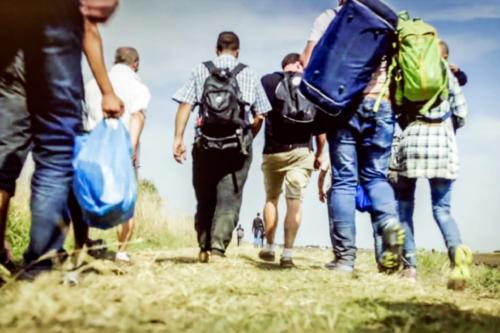Forced internal displacement in Mexico and processes of violence
Regarding the causes of Forced Internal Displacement for that year (2020), the processes of violence produced by organized armed groups affected 6,257 people from the entities of Chihuahua, Guerrero, Michoacán, Sinaloa and Sonora.
- Opinión

In the global context, Forced Internal Displacements are processes that, for decades and year after year, have affected tens of millions of people in different regions of the world. According to data from international organizations such as the IDMC, it was estimated that by 2020 there were more than 40 million internally displaced persons (IDMC, 2021). And the structural causes of Forced Internal Displacement are fundamentally two. 1) On the one hand, the impacts and repercussions of natural and environmental phenomena (hurricanes, tsunamis, droughts, etc.) on human settlements. 2) On the other hand, the anthropic sociopolitical processes in various countries (conflicts, contexts of violence, armed groups, among others) (Castillo, 2019).
In the case of Mexico, and according to the report "Episodes of massive forced internal displacement in Mexico (2020)", these are processes that have existed since the second half of the last century and that, in the context of the war against drug trafficking of the neoliberal administration of Calderón (2006 - 2012), grew rapidly and was focused in certain regions of the country, particularly in some states. Considering the historical accumulation of people affected by dynamics of Forced Internal Displacement carried out by the Mexican Commission for the Defense and Promotion of Human Rights, there is an estimated 356,792 people affected during the period from 2006 to 2020 (CMDPDH, 2021).
For the year 2020, there was a record of 9,741 internally displaced persons in Mexico (CMDPDH, 2021), and with a clear process of geographic selectivity. The states affected were eight: Chiapas, Chihuahua, Guerrero, Michoacán, Oaxaca, Quintana Roo, Sinaloa and Sonora; and in total there were 25 municipalities and 66 localities involved (CMDPDH, 2021). And, in this differentiated dynamic, the states with the highest number of internally displaced persons were those related to organized crime (especially drug trafficking) and also those with processes of different conflicts and contexts of violence (CMDPDH, 2021). Guerrero was the state with the highest number of displaced persons, with 3,952 people (with 4 affected municipalities and 24 impacted localities). Then there was Chiapas (with 2,056 people, from 4 municipalities and 12 localities), followed by Oaxaca (with 1,328 people, from 5 municipalities and 6 localities) and, in fourth place, Michoacán (with 1,049 people, from 3 municipalities and 8 localities) (CMDPDH, 2021).
Regarding the causes of Forced Internal Displacement for that year (2020), the processes of violence produced by organized armed groups affected 6,257 people from the entities of Chihuahua, Guerrero, Michoacán, Sinaloa and Sonora; which represented 64.23% of the total number of displaced persons (CMDPDH, 2021). And the other major cause of Forced Internal Displacement was political violence (related to social unrest, paramilitarism and territorial conflicts), which affected 3,484 individuals (35.77% of the total), and the entities involved were Chiapas, Oaxaca and Quintana. Roo (CMDPDH, 2021).
Forced Internal Displacement continues to be a process and problem present in Mexico, which affects thousands of individuals each year, and which, considering the panorama of the last three decades, has impacted hundreds of thousands of people. The genesis and current explanation of this process is linked to the structural historical production of contexts of violence in two fundamental axes. On the one hand, the generalized, frontal and indiscriminate war with organized crime (mainly drug trafficking) that began in the mid-2000s. On the other hand, the actions of certain groups (paramilitaries) that cause dispossession and socio-territorial conflicts, in different entities in the south of the country (such as Chiapas and Guerrero).
Notes
Castillo. G. (2019). Forced internal displacement in Mexico: scenarios of violence and human rights violations. REDODEM Report 2019: Migrations in Mexico: borders, omissions and transgressions (pp. 59-84). REDODEM: Mexico.
CMDPDH. (2021). Episodes of massive forced internal displacement in Mexico. 2020 Report. CMDPDH: Mexico. Retrieved from: https://www.cmdpdh.org/publicaciones-pdf/cmdpdh-episodios-de-desplazamie...
IDMC. (2021). Global Report on Internal Displacement. IDMC: Norway.
Del mismo autor
- Forced internal displacement in Mexico and processes of violence 13/03/2022
- Labor struggles against precarious work and agribusiness exploitation 09/01/2022
- Detentions, deportations, and criminalization of migrants 29/11/2021
- México: detenciones, deportaciones y criminalización de los migrantes 15/11/2021
- Visibility of migrant voices and subjects 18/10/2021
- La decolonialidad y el abordaje de las movilidades humanas transfronterizas 01/10/2021
- Migrants, social organizations, and policies to control cross-border mobility 20/09/2021
- Decoloniality and sense of the production of social knowledge 06/09/2021
- Decolonialidad y sentido de la producción de conocimiento social 26/08/2021
- México: migrantes, organizaciones sociales y políticas del control de las movilidades transfronterizas 09/08/2021
